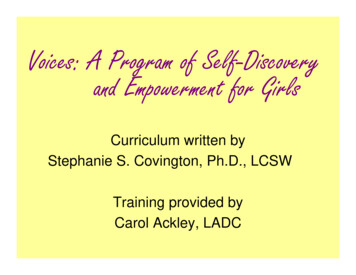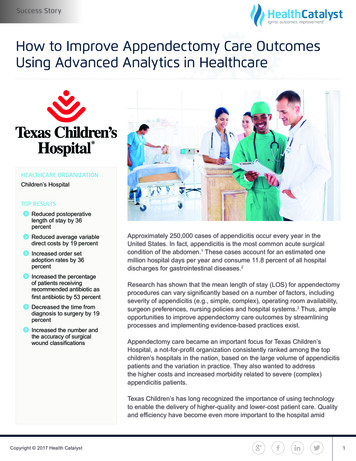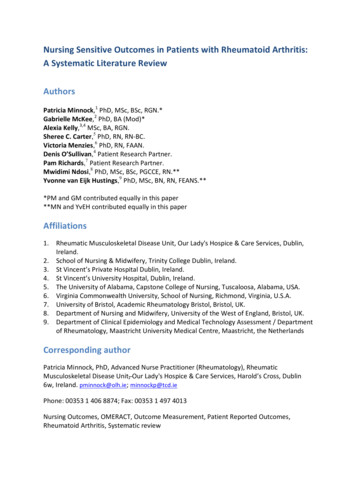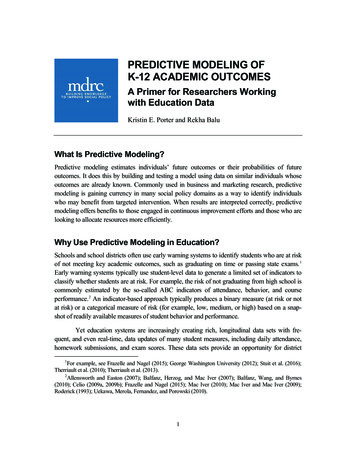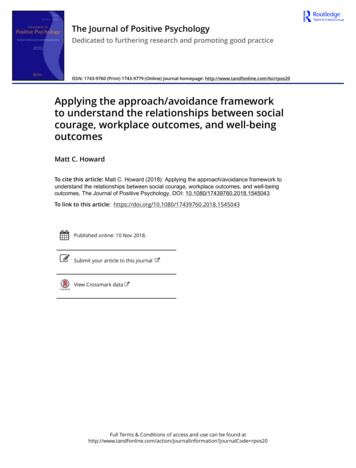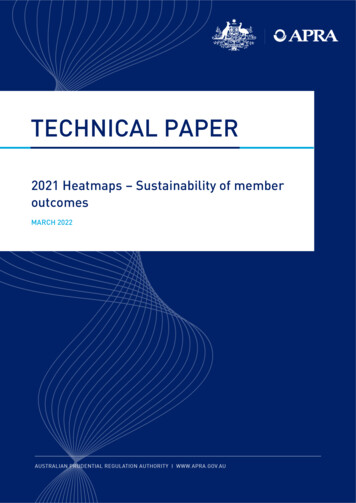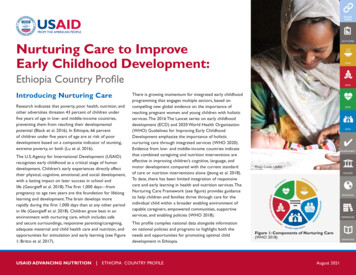
Transcription
QUICKLINKSOUTCOMESNurturing Care to ImproveEarly Childhood Development:DATAEthiopia Country ProfileIntroducing Nurturing CareResearch indicates that poverty, poor health, nutrition, andother adversities threaten 43 percent of children underfive years of age in low- and middle-income countries,preventing them from reaching their developmentalpotential (Black et al. 2016). In Ethiopia, 66 percentof children under five years of age are at risk of poordevelopment based on a composite indicator of stunting,extreme poverty, or both (Lu et al. 2016).The U.S. Agency for International Development (USAID)recognizes early childhood as a critical stage of humandevelopment. Children’s early experiences directly affecttheir physical, cognitive, emotional, and social development,with a lasting impact on later success in school andlife (Georgieff et al. 2018). The first 1,000 days—frompregnancy to age two years are the foundation for lifelonglearning and development. The brain develops morerapidly during the first 1,000 days than at any other periodin life (Georgieff et al. 2018). Children grow best in anenvironment with nurturing care, which includes safeand secure surroundings, responsive parenting/caregiving,adequate maternal and child health care and nutrition, andopportunities for stimulation and early learning (see Figure1; Britto et al. 2017).USAID ADVANCING NUTRITION DATAThere is growing momentum for integrated early childhoodprogramming that engages multiple sectors, based oncompelling new global evidence on the importance ofreaching pregnant women and young children with holisticservices. The 2016 The Lancet series on early childhooddevelopment (ECD) and 2020 World Health Organization(WHO) Guidelines for Improving Early ChildhoodDevelopment emphasize the importance of holisticnurturing care through integrated services (WHO 2020).Evidence from low- and middle-income countries indicatethat combined caregiving and nutrition interventions areeffective in improving children’s cognitive, language, andmotor development compared with the current standardof care or nutrition interventions alone (Jeong et al. 2018).To date, there has been limited integration of responsivecare and early learning in health and nutrition services. TheNurturing Care Framework (see figure) provides guidanceto help children and families thrive through care for theindividual child within a broader enabling environment ofcapable caregivers, empowered communities, supportiveservices, and enabling policies (WHO 2018).This profile compiles national data alongside informationon national policies and programs to highlight both theneeds and opportunities for promoting optimal childdevelopment in Ethiopia.ETHIOPIA COUNTRY PROFILEDATADATAENVIRONMENTPhoto Credit: USAIDPOLICIESPROGRAMSREFERENCESFigure 1: Components of Nurturing Care(WHO 2018)August 2021DEFINITIONS
Key Nurturing Care and EarlyChildhood Development IndicatorsThis profile presents data on nurturing care and earlychildhood development. The WHO’s (2020) Guidelinesfor Improving ECD provide useful definitions of thesetwo terms:Children under-5at risk of not reachingdevelopmentalpotential“Early childhood development: Refers tothe cognitive, physical, language, motor, social andemotional development between 0–8 years of age.Nurturing care: Characterized by a caregivingenvironment that is sensitive to children’s health andnutritional needs, responsive, emotionally supportive,and developmentally stimulating and appropriate,with opportunities for play and exploration andprotection from adversities.”72%(2004)Children ages 36–59months that are notdevelopmentally ontrack5per 100,000populationAttention DeficitHyperactivity Disorder179 (2016)Autism SpectrumDisorders706 (2016)66%Epilepsy803 (2016)(2010)In brief, nurturing care supports children to surviveand reach their full potential and ECD representsthe outcomes measured. Nurturing care is importantfor everyone, and is especially important in theearliest years of a child’s life from ages 0 to 3, as thisis a period of rapid brain development that sets thefoundation for later health and well-being. Data arepresented for only four—nutrition, safety and security,health, and early learning—of the five domains ofnurturing care because there are currently no globalindicators and data on responsive caregiving. Detailedindicator definitions and sources are located at theend of the document. To access an indicator definition,click on the title of the indicator. The data presentedhere provide a country-level overview, and thereis likely in-country variability due to populationdemographics or geography.USAID ADVANCING NUTRITIONDevelopmentaldisability inchildren underIntellectual Disability2,455 (2016)Hearing Loss2,729 (2016)No Data ETHIOPIA COUNTRY PROFILEVision Loss3,420 (2016)2
StuntingNutrition1008060100Minimumacceptable dietWasting2008038% 10%7%20162019Exclusivebreastfeeding for6 monthsUnderweight10058% 59%806060404020200201602019Early initiationof breastfeeding10080 100604040202020162019ETHIOPIA COUNTRY PROFILE20162019Low birthweight80600USAID ADVANCING NUTRITION73% 72%24% 21%0No DataNo Data3
Early LearningHealthPreterm birthsSupport for learningNo DataInadequate supervision12% (2014)No DataUnder-5 mortality rateNo Data1008060Availability ofchildren’s booksUSAID ADVANCING NUTRITION625140No Data Positive disciplineNo DataAttendance in earlychildhood educationAvailability ofplaythingsSafety and Security200(2015)ETHIOPIA COUNTRY PROFILE(2019)No Data36%Children living inpoverty(2015)Children covered bysocial protection systemsNo Data4
Policy Environment for Supporting Improved ECDPaid maternity leaveHealth workers requiredto receive training inpromoting ECDPaid paternity leaveRegular coordinationmeetings at thesub-national levelFree antenataland delivery careMinistry/agencytasked with nationalmulti-sectoralECD coordinationFree health care forchildren under-5Laws protect the rights ofchildren with disabilities andpromote their participationand access to ECD servicesFree pre-primaryeducationMulti-sectoral ECD strategyRequired birth registrationKey: policy in place no policy information not availableUSAID ADVANCING NUTRITION ETHIOPIA COUNTRY PROFILE5
Overview of Policies Related to Improving ECD in EthiopiaThe Ministry of Health is responsible for multi-sectoral coordination to improve ECD in Ethiopia.Ministry of Health (MoH)2016–20202020/2021– 2024/2025National Nutrition Program (NNP II)National Health Sector Strategic Plan for EarlyChildhood DevelopmentThe second National Nutrition Program (NNP II) is anationwide inter-sectoral program that provides a frameworkfor coordinating the implementation of nutrition interventionsto reduce malnutrition and achieve zero hunger by 2030 andmeet Sustainable Development Goal (SDG) targets. The NNP II ischaired by the MoH and co-chaired by the ministries of agricultureand education. The main strategy is to have an integrated approachlinking nutritional needs and improving the agricultural, breeding,and aquaculture sectors. The interventions under NNP II includeoptimal breastfeeding; optimal complementary feeding; mitigationand prevention of micronutrient deficiencies; improving water,sanitation, and hygiene (WASH); deworming; food fortification; andmanagement of acute malnutrition. The second strategic objectiveof the NNP II is to improve the nutritional status of infantsand young children 0–59 months. Several initiatives under thisobjective specifically target breastfeeding, complementary feeding,growth monitoring of children under-2 years, supporting familiesof children under-2 years, and integrating early childhood careand development into existing community and facility-based childnutrition programs.USAID ADVANCING NUTRITION ETHIOPIA COUNTRY PROFILEThis strategic plan provides a detailed roadmap and framework todesign and implement programs, which ensures that all childrengrow and thrive in a secure, safe, and nurturing environment thatpromotes their physical, intellectual, linguistic, and social emotionaldevelopment. Furthermore, it supports the SDG targets for childhealth and well-being. The primary focus are young children frombirth to 6 years old and their parents, caregivers, families, andcommunities—priority is given to children and their parents livingin difficult circumstances and adverse environments. One of themain activities listed under the plan is integrating additional ECDrelated interventions with existing health, nutrition, and WASHservices in target regions and woredas (districts). The plan alsocalls for developing guidelines and conducting hands-on trainingto increase the capacity of health service providers and otherimplementers to support parents and caregivers to engage in earlystimulation and responsive caregiving for their young children. Thiswill happen during counseling at health facilities and home visits;and establishing early stimulation/play areas in health facilities,childcare centers, and other settings to model and foster earlylearning activities. Finally, to facilitate integrated and holistic ECDservice delivery the plan looks to streamline and strengthen thecross-sectoral coordination mechanisms at the federal and subnational levels.6
2020/2021– 2024/2025Health Sector Transformation Plan II(HSTP II)HSTP II is the health sector’s five year strategic plan thataims to improve the health of the population by realizingand accelerating progress toward Universal Health Coverage(UHC), protecting people from emergencies, creatingworeda (district) transformation, and making the healthsystem responsive to people’s needs and expectations. Theplan aspires to achieve UHC through expanding access toservices and improving the provision of quality, equitable,and comprehensive health services at all levels. The missionof the HSTP II is to promote the health and well-being ofthe society by providing and regulating a comprehensivepackage of health services at the highest possible quality, inan equitable manner. Among many of the targets listed inthe HSTP II are several targets aimed specifically towardyoung children and their caregivers. These targets includedecreasing neonatal, infant, and child mortality; decreasingstunting and wasting prevalence in children under-5years; and strengthening and scaling up deworming andmicronutrient supplementation to children and women inneed, including pregnant and lactating women. Furthermore,the HSTP II aims to strengthen and expand nutritionalscreening of children, pregnant and lactating women, andHIV-positive individuals; and managing moderate and severemalnutrition to ensure that all Ethiopians—no mattertheir geography, gender, age, wealth, education or disabilitystatus—can attain the same high levels of health outcomesand access to essential services.USAID ADVANCING NUTRITION ETHIOPIA COUNTRY PROFILEPhoto Credit: Save the Children7
2015/2016– 2019/20202016–2020National Strategy for Newborn and ChildSurvival in EthiopiaEthiopia National Expanded Programme onImmunizationThe National Strategy for Newborn and Child Survival in Ethiopiabuilds upon the first comprehensive National Child SurvivalStrategy (2005–2015). The strategy plans to ensure universalcoverage of quality, high impact newborn and child healthinterventions, including meaningful community empowerment.The strategy, part of the first HSTP, identified 39 high impactand cost effective newborn and child survival interventions withkey guiding principles for implementation. This included equityand accessibility; community engagement, empowerment, andownership; integration; partnership; efficient use of resources;innovation and use of technology; evidence-based decisionmaking; and provision of quality services. The strategy envisionsevery child in Ethiopia enjoying the highest attainable standardof health and development, with an end to all preventable childdeaths by 2035. The objectives are to ensure effective universalcoverage of high impact neonatal and child survival interventionswith special focus on the poorest and marginalized sections ofthe population; to ensure the provision of high quality essentialhealth care for mothers, newborns, and children at the communityand health facility levels; to ensure community empowerment anddemand creation for effective use of newborn and child survivalinterventions; and the promotion of key family and communitycare practices. The strategy also looks to conduct regular mappingof households with pregnant women, newborns, and childrenunder-5 years to achieve its goals and vision.The primary objective of the Ethiopia National ExpandedProgramme on Immunization was to achieve at least 90% nationalcoverage of all vaccines in every district by 2020. The plan alsoaimed to reduce the incidence of vaccine preventable diseasesthrough integrated interventions that would strengthen theoverall health system. The plan encompasses all components ofimmunization services, such as service delivery, vaccine supply,quality and logistics, disease surveillance and accelerated diseasecontrol, advocacy, social mobilization and communication, andprogram management. The main focus of the plan were children ofunder-1 years and women of reproductive age.USAID ADVANCING NUTRITION ETHIOPIA COUNTRY PROFILEPhoto Credit: USAID8
Ministry of Education (MoE)National WASH Coordination Office20102013–2020National Policy Framework for EarlyChildhood Care and Education (ECCE)The National Policy Framework for ECCE focuses on enhancingthe quality, accessibility, and equitable distribution of services foryoung children. The policy aims to do this through more efficientpartnerships and capacity building programs. Programs targetedin this policy are parental education, health and early stimulationprograms for children from birth to 3 years, pre-school andcommunity-based kindergartens for children from 4 to 6 years, andcommunity based informal school readiness programs. The policy’svision is to provide all children the right to a healthy start in life,to be nurtured in a safe, caring, and stimulating environment, andto develop their fullest potential. The National Policy Frameworkfor ECCE also underlines the importance of active involvement ofparents in ECCE programs.USAID ADVANCING NUTRITION ETHIOPIA COUNTRY PROFILEOne WASH National Program (OWNP)The OWNP brings together ministries, development partners,academia, and civil society organizations in a common goal of oneplan, one budget, and one report for improving WASH. The aim ofthe program is to improve the health and well-being of communitiesin rural and urban areas by increasing equal and sustainable accessto clean water supplies, sanitation services, and good hygienepractices. To achieve success, the program brings together four keygovernment ministries: the Ministry of Water, Irrigation and Energy;MoH; MoE; and the Ministry of Finance and Economic Development,including all their related sectors to modernize the way WASHservices are delivered. OWNP combines a comprehensive rangeof interventions, including capital investments to extend first-timeaccess to water and sanitation, as well as investments focused ondeveloping an enabling environment, building capacities, ensuring thesustainability of service delivery, with a focus on behavior change.Phase one of the OWNP was from 2013 until 2017 and resulted in18.7 million people gaining access to water supplies, the reductionof open defecation practices from 44% to 29%, and construction of1,280 WASH facilities in schools. In phase two, the program createdtargeted behavioral change in families toward practices specificto young children. Practices include all households with childrenwashing their infants and children under-5 years and proper disposalof children’s feces.9
Ministry of Labour and Social Affairs (MoLSA)2012–2021National Plan of Action of Persons withDisabilitiesThe Ethiopian National Plan of Action of Persons with Disabilitiespresents a plan for enabling Ethiopia to become a more inclusivesociety. It addresses the needs of persons with disabilities in Ethiopiafor comprehensive rehabilitation services; equal opportunities foreducation, skills training, and work; and full participation in the life oftheir families, communities, and the nation. The plan envisions a fullyinclusive society in Ethiopia where all children, youth, and adults withdisabilities—regardless of gender or type of disability, as well as theirparents and families—enjoy the same rights to participate in civil,political, economic, social, and cultural spheres. It also aims to improveaccess to medical services, educational services, and social services; andtraining, work, and leisure opportunities for persons with disabilities.The policy has 13 objectives, including raising awareness; improvingaccess and quality of services; providing educational and vocationalskills training; supporting culture, sports, and recreation opportunities;and supporting accessible living and transportation. Among the manyactivities listed in the plan are activities directly aimed to supportchildren with disabilities and their families. These activities includeincreasing the capacity of community health and development workersfor early identification, early intervention, and service delivery topersons with disabilities. Also, the plan aims to strengthen communitybased rehabilitation programs to work with persons with disabilities,parents, and family members in the home to improve the lives ofchildren with developmental, physical, and sensory impairments.Photo Credit: USAIDUSAID ADVANCING NUTRITION ETHIOPIA COUNTRY PROFILE10
Ministry of Women, Children and Youth Affairs (MoWCYA)2010–2015National Strategy and Action Plan on HarmfulTraditional Practices (HTPs) against Women andChildren in EthiopiaThe National Strategy and Action Plan on HTPs against Women andChildren in Ethiopia was inspired by a vision of creating a nation freeof HTPs and where women and all children enjoy their fundamentalrights and freedoms. The mission of the strategy is to provide a strategicdirection, an institutional framework, principles, and actions for theprevention and elimination of all forms of HTPs. Of the many HTPs thatthe strategy focuses on are practices that endanger or cause harm topregnant women and children, in particular female genital mutilation/cutting, uvulectomy, milk-teeth extraction, abduction, child abuse, andchild marriage. The strategy’s overall objective is to institutionalizenational, regional, and grassroots-level mechanisms by creating anenabling environment for the prevention and elimination of all formsof HTPs, and to ensure multi-sectoral services are available to supportwomen and children.Photo Credit: Save the ChildrenUSAID ADVANCING NUTRITION ETHIOPIA COUNTRY PROFILE11
Current and Recent Programs for Improving ECDEach number represents a different program. Click on the number to jump to the next pages to learn more.Central Tigray10Amhara8, 10Addis Ababa City1, 2, 5, 8Southern Nations,Nationalities, andPeoples' RegionsOromia1, 2, 3, 42National level: 6, 7, 11USAID ADVANCING NUTRITION ETHIOPIA COUNTRY PROFILENot available: 912
Current and Recent Programs for Improving ECDProgramOverviewKey Activities1. Newborn SurvivalProjectImplementer: Doctors with Africa CUAMMTimeline: 2018–2021Regions: Oromia and Addis Ababa CityAdministrationKey Government Partner: Federal Ministry ofHealthFunder: Italian Agency for DevelopmentCooperationThe program reduces neonatal mortality at St. Paul, Tulubolo, and Wolisso St. Luke Catholic hospitals bystrengthening newborn care services. Utilizing the ECD training manuals drafted by the MOH, the projecttrains health workers in the three hospitals on newborn care which includes components on nurturing caresuch as parenting practices and play. The project also conducted supportive supervision and procured medicalequipment, supplies and drugs necessary to provide quality newborn care services. The project has constructeda Level II newborn care center for the specialized care for small and sick newborns at Wolisso St. Luke CatholicHospital and equipped it with medical equipment and oxygen supply systems. At the community level, theproject has conducted activities to increase parents’ knowledge and practices about home-based newborn carepractices, as well as early identification of neonatal danger signs and corresponding measures to be taken. Theproject also procured ambulances to transport laboring women, and sick newborns from home to nearby healthfacilities. The project conducted research on newborn care practices, parents’ satisfaction surveys on newborncare practices, as well as identifying the causes of newborn mortalities in supported hospitals.2. Brueh Tesfa—DemonstratingPathways to Scalefor NurturingCare throughEngagement,Leadership,and SystemsStrengtheningImplementer: PATHTimeline: 2019–2022Regions: Ababa City Administration, Oromia,and Southern Nations, Nationalities, andPeoples' RegionsKey Government Partners: Federal Ministry ofHealth and the Addis Ababa City AdministrationHealth BureauFunder: Bainum Family FoundationPATH works to improve children’s developmental outcomes through supporting the Federal Ministry of Health’sefforts to strengthen the enabling policy environment for promoting child development through the healthsector, as well as leverage the platforms to ensure that children 0–3 years receive comprehensive nurturing carethrough multiple maternal, newborn, child health, and nutrition touch-points.The key activities include: (1) support inclusion of missing nurturing care content in national policies, trainingcurricula, service delivery guidelines, information, education, and communication materials, job aids, data systems,planning documents, and annual budgets for sustainability; (2) adapt training and communication materials frommature ECD programs in Kenya and Mozambique; (3) establish partnerships with stakeholders and providetechnical assistance to partners; (4) expand the evidence base for nurturing care programming through learning,knowledge management, and communication; and (5) capacity building of facility- and community-based healthservice providers. Capacity building promotes interventions that include the following: (1) counseling/parentalcoaching on nurturing care for ECD, with a focus on components typically missing from routine health services(i.e., responsive caregiving, early learning, and safety and security); (2) developmental milestone monitoring toidentify children with developmental problems and link them to appropriate services; and (3) playbox sessions inhealth facility waiting areas, as well as in daycare centers and other community platforms.BACK TO MAPUSAID ADVANCING NUTRITION ETHIOPIA COUNTRY PROFILE13
ProgramOverviewKey Activities3. Early ChildhoodDevelopment inRural Low LiteracySettings of EthiopiaImplementer: Children BelieveTimeline: 2014–2016Region: OromiaKey Government Partners: MoH and MoWCYAFunder: Grand Challenges CanadaThe two-year pilot project served rural and underserved communities and aimed to improve the health, andthe physical, cognitive, linguistic and socio-emotional development of children 0–3 years. The project launchedLearning Through Play with an audio-visual early brain development education program that health extensionworkers and social workers delivered to parents in rural and low-literacy communities. The knowledge deliveryapproach was effective in improving parents’ and caregivers’ knowledge, skills, and behaviors in child-rearing,which also brought about a positive and measurable change in the physical, cognitive, language, and socioemotional development of children 0–3 years. The project increased early stimulation and attachment practicesamong parents, improved problem solving, communication, personal-social, emotional and physical developmentof children, and improved fathers’ involvement in care and nurturing their young children.4. Development FoodSecurity Activity(DFSA)Implementer: CRS EthiopiaTimeline: 2016–2021Region: OromiaKey Government Partners:Ministry of Agriculture (MoA), Ministryof Water and Energy, Ministry of Health,MoWCYA, MoLSA, and MoEFunder: USAIDDFSA improves the nutritional status of pregnant and lactating women and children under-5 years by takinga systems-strengthening approach to advance the goals of the NNP II. Focusing on government Health andAgriculture Extension Programs, DFSA is strengthening the quality and coordination of services at thecommunity, kebele, and woreda levels, thus ensuring that households increase their utilization of preventive andcurative health and nutrition services, consume an adequate diet, and mitigate environmental risks to health andnutrition. These efforts are complemented by harmonization of approaches and effective geographic layering,particularly in nutrition-sensitive agriculture with the Feed the Future–funded Growth through NutritionActivity.5. Children: TheFuture Hopeof Addis AbabaEarly ChildhoodDevelopmentInitiativeImplementer: Addis Ababa City AdministrationTimeline: 2021–2025Region: Addis Ababa City AdministrationKey Government Partners:MoH, MoE, MoLSA, MoWCYA, and Ministry ofTransportFunders: Big Win and Bernard van LeerFoundationThis initiative targets children at home, in schools, and in communities, creating a conducive environment thatcaters to the wide-ranging growth needs of children. The initial phase adopts a model of intensified support tovulnerable families and children, while striving to provide universal access to comprehensive ECD services to allchildren.The program builds on existing solid platforms, including the Urban Health Extension Program and FamilyHealth teams, the Urban Safety Net Program, and the expansion of public schools including pre-primary. Theinitiative focuses on nine key strategic areas: (1) implementation of parent coaching; (2) community-run ECDcenters; (3) publicly financed day care centers; (4) expanded access to pre-primary schools; (5) establishmentof an ECD Center of Excellence; (6) learn through play; (7) effective cross-sectoral governance; (8) improvedregulatory standards; and (9) measurement, learning, accountability, and data for decision-making.BACK TO MAPUSAID ADVANCING NUTRITION ETHIOPIA COUNTRY PROFILE14
ProgramOverviewKey Activities6. WHO in EthiopiaImplementer: WHOTimeline: OngoingRegions: National levelKey Government Partner: MoHFunder: Not availableWHO is working closely with the Federal MoH and partners to improve children’s health in Ethiopia. WHO’smain role is at the national level, providing technical and financial support for developing national strategicdocuments, guidelines, tools, and capacity building of health workers and program officers in various maternalnewborn and child health programs. Most recently, WHO supported the facilitation of the First Joint NationalSensitization Workshop on Early Childhood Development & Education in Ethiopia. The workshop broughttogether over 200 key stakeholders from ministries, regions, universities, donors, implementing partners, civilsociety organizations, and media, with the main objective of sensitizing higher officials on the importanceof investing in ECD and strengthening the multi-sectoral coordination toward the implementation of ECD.Additionally, WHO supported national capacity building training on Care for Child Development and preparingcounseling job aids and training material on ECD for use by community health workers. WHO technicallysupported the development of National Health Sector Strategic Plan for Early Childhood Development inEthiopia, the adaptation of the ECD training material and integration of child development into the IntegratedManagement of Newborn and Childhood Illnesses guidelines in Ethiopia. WHO will continue supporting Ethiopiain their long-term goal of ending all preventable child deaths in the next two decades. In addition, WHO hassupported testing of the Caregiver Skills Training program to support caregivers of children with disabilities inEthiopia.7. United NationsChildren’s Fund(UNICEF) inEthiopiaImplementer: UNICEFTimeline: OngoingRegions: National LevelKey Government Partners: MoH, MoE,MoA, National WASH Coordination Office,MoWCYA.Funder: Not availableIn Ethiopia, UNICEF works to support national efforts to ensure the realization of the rights of children andwomen through improved child survival, development, and protection. UNICEF’s work focuses on survivaland health, social policy and evidence for social inclusion, child protection, learning and development, WASH,and nutrition. UNICEF supports the government to develop evidence-based policies and strategies, leverageresources, and monitor and evaluate progress toward universal health care focusing on the most disadvantagedand underserved children and women. Furthermore, UNICEF supports the government’s national nutritionprogram, particularly the community-based nutrition program, which aims to increase knowledge on essentialnutrition actions and broader infant and young child feeding practices through Ethiopia’s Health ExtensionProgram. Using community platforms in underserved populations, UNICEF helps to improve health-seekingbehaviors by addressing harmful traditional beliefs and negative social norms and enhancing social accountability.UNICEF also provides essential lifesaving services to the most vulnerable children during emergencies andworks with the government’s disaster risk management and food security sector to build the capacity of thegovernment and partners, including community stakeholders, to identify vulnerabilities and risks and delivercoordinated emergency preparedness and response.BACK TO MAPUSAID ADVANCING NUTRITION ETHIOPIA COUNTRY PROFILE15
ProgramOverviewKey Activities8. Pilot communitychildcare centersunder the RuralProductive SafetyNet Program(PSNP) and UrbanProductive Sa
life (Georgieff et al. 2018). The first 1,000 days—from pregnancy to age two years are the foundation for lifelong learning and development. The brain develops more rapidly during the first 1,000 days than at any other period in life (Georgieff et al. 2018). Children grow best in an environment with nurturing care, which includes safe


